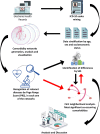Comorbidity patterns in cardiovascular diseases: the role of life-stage and socioeconomic status
- PMID: 38414921
- PMCID: PMC10897012
- DOI: 10.3389/fcvm.2024.1215458
Comorbidity patterns in cardiovascular diseases: the role of life-stage and socioeconomic status
Abstract
Cardiovascular diseases stand as a prominent global cause of mortality, their intricate origins often entwined with comorbidities and multimorbid conditions. Acknowledging the pivotal roles of age, sex, and social determinants of health in shaping the onset and progression of these diseases, our study delves into the nuanced interplay between life-stage, socioeconomic status, and comorbidity patterns within cardiovascular diseases. Leveraging data from a cross-sectional survey encompassing Mexican adults, we unearth a robust association between these variables and the prevalence of comorbidities linked to cardiovascular conditions. To foster a comprehensive understanding of multimorbidity patterns across diverse life-stages, we scrutinize an extensive dataset comprising 47,377 cases diagnosed with cardiovascular ailments at Mexico's national reference hospital. Extracting sociodemographic details, primary diagnoses prompting hospitalization, and additional conditions identified through ICD-10 codes, we unveil subtle yet significant associations and discuss pertinent specific cases. Our results underscore a noteworthy trend: younger patients of lower socioeconomic status exhibit a heightened likelihood of cardiovascular comorbidities compared to their older counterparts with a higher socioeconomic status. By empowering clinicians to discern non-evident comorbidities, our study aims to refine therapeutic designs. These findings offer profound insights into the intricate interplay among life-stage, socioeconomic status, and comorbidity patterns within cardiovascular diseases. Armed with data-supported approaches that account for these factors, clinical practices stand to be enhanced, and public health policies informed, ultimately advancing the prevention and management of cardiovascular disease in Mexico.
Keywords: cardiovascular diseases; comorbidities; diseasome; health care; human disease network; socioeconomic status.
© 2024 Cruz-Ávila, Ramírez-Alatriste, Martínez-García and Hernández-Lemus.
Conflict of interest statement
The authors declare that the research was conducted in the absence of any commercial or financial relationships that could be construed as a potential conflict of interest.
Figures







Similar articles
-
Comorbidity Networks in Cardiovascular Diseases.Front Physiol. 2020 Aug 28;11:1009. doi: 10.3389/fphys.2020.01009. eCollection 2020. Front Physiol. 2020. PMID: 32982776 Free PMC article.
-
The influence of age, gender and socio-economic status on multimorbidity patterns in primary care. First results from the multicare cohort study.BMC Health Serv Res. 2012 Apr 3;12:89. doi: 10.1186/1472-6963-12-89. BMC Health Serv Res. 2012. PMID: 22471952 Free PMC article.
-
Comorbidity network for chronic disease: A novel approach to understand type 2 diabetes progression.Int J Med Inform. 2018 Jul;115:1-9. doi: 10.1016/j.ijmedinf.2018.04.001. Epub 2018 Apr 9. Int J Med Inform. 2018. PMID: 29779710
-
Controversies and evidence for cardiovascular disease in the diverse Hispanic population.J Vasc Surg. 2018 Mar;67(3):960-969. doi: 10.1016/j.jvs.2017.06.111. Epub 2017 Sep 23. J Vasc Surg. 2018. PMID: 28951154 Review.
-
Sociodemographic, socioeconomic, and clinical determinants of survival in patients with cancer: A systematic review of the literature focused on the elderly.J Geriatr Oncol. 2018 Jan;9(1):6-14. doi: 10.1016/j.jgo.2017.07.007. Epub 2017 Oct 10. J Geriatr Oncol. 2018. PMID: 29030150
Cited by
-
Development and validation of nomograms for predicting cardiovascular disease risk in patients with prediabetes and diabetes.Sci Rep. 2024 Sep 8;14(1):20909. doi: 10.1038/s41598-024-71904-3. Sci Rep. 2024. PMID: 39245747 Free PMC article.
References
LinkOut - more resources
Full Text Sources

